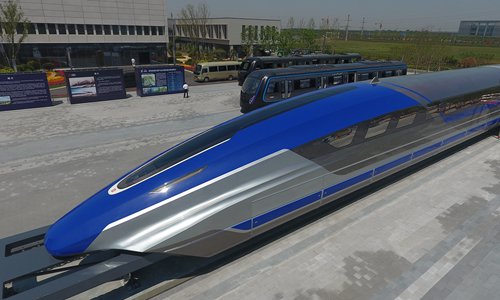HOME >> BUSINESS
China steps up development of maglev trains
Source:Xinhua Published: 2019/9/19 19:33:42
Technology brings new possibilities for future transportation

Models of maglev trains with a top speed of 600 km/h were launched at a factory in Qingdao, East China's Shandong Province, in May. Photo: VCG
Technicians are busy examining a new magnetic-levitation train prototype in a factory in Zhuzhou, Central China's Hunan Province.Zhuzhou, a city known as a forerunner of China's rail transit manufacturing industry, is fostering innovation and production of maglev trains.
"We have been pursuing independent research of maglev technology and manufacturing maglev trains with our own intellectual property rights," said Zhou Qinghe, President of CRRC Zhuzhou Locomotive Co (ZLCL), a rail transit equipment maker and a subsidiary of China Railway Rolling Stock Corp (CRRC).
Shanghai saw China's first commercial maglev system, a 30-km stretch between the downtown area and the city's Pudong airport, which was put into operation in 2003. But the system was based on German maglev technology.
Fully supported by its own technology, China's first medium-and-low-speed maglev line with a design speed of 100 km/h began operation in May 2016 in Changsha, Hunan Province.
As of the end of August, the Changsha maglev line had an operation mileage of 3.07 million km and had transported more than 10 million passengers.
According to Tong Laisheng, head of the Maglev Research Institute of the CRRC ZLCL, they have been aiming for new breakthroughs and more advanced versions of commercial maglev trains.
The 2.0 version of the maglev, with a design speed of 160 km/h, is being tested and a more advanced, driverless maglev train with a top speed of 200 km/h is being developed, Tong said.
"The driverless version can climb to the height of a four-story building in 100 m, just like a roller coaster. It will be equipped with a communication-based train control system that combines big-data analysis, realizing real-time diagnoses of trains, maglev tracks and power supply," Tong said.
Liu Youmei, an academician of the Chinese Academy of Engineering, said that China has mastered the core technology for commercial maglev trains and established a system with intellectual property rights, ranging from research, manufacturing and test verification to commercial operation.
China has seen a rapid development of rail transit in recent years with its fast urbanization.
Statistics from the China Association of Metros showed that a total of 37 cities on the Chinese mainland had rail transit systems in operation as of June 30, with a total length of 6,126.82 km.
China's urban rail transit has not only achieved rapid growth in scale but also achieved high-quality development, said Xie Zhengguang, President of the Association.
Tong is confident about the prospects of maglev trains, as they offer an alternative to traditional rail and subway systems which have their own advantages in urban transit.
Maglev trains create less noise as there is no wheel-rail friction. Also, their minimum turning radius is only half that of a subway, allowing it to more easily bypass buildings in route planning and thereby avoid relocation, Tong said.
It is also more economical; the comprehensive cost per kilometer is only about a third of a subway and three-quarters of a light rail, he said.
Some Chinese cities such as Qingyuan in Guangdong Province have begun maglev-line projects, and more cities such as Chengdu in Sichuan Province and Jinan in Shandong Province are adding maglev lines into their transportation planning to connect city clusters and boost regional integration.
"More than 200 delegations from 35 countries and regions have come to Hunan Province to investigate our maglev lines. We will take into consideration the characteristics of different places, and design customized maglev trains in the future," Tong said.
Zhou said that the fast development of maglev trains is expected to foster a strong industrial chain.
"More than 90 percent of the 10,000 types of components used in the medium-and-low maglev trains are now purchased in China, which will bring new opportunities for many relevant industries including machinery, electronics and new materials," Zhou said.
Apart from the commercial operation of medium-and-low speed maglev lines, China is fostering research on more maglev train variants. A prototype of the high-speed maglev train with a design speed of 600 km/h was unveiled in Qingdao, Shandong Province, in May.
Newspaper headline: Nation steps up development of maglev trains
RELATED ARTICLES:
Posted in: INDUSTRIES